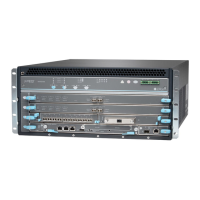NOTE: The power for the cooling system comes from a different tap on the power supply,
reserved for the cooling system only. The cooling system power requirement does not
need to be deducted from the output power budget of the power supply.
Table 34 on page 156 lists the power supplies, their maximum output power, and unused power (or a
power deficit) for an AC-powered services gateway. Table 35 on page 156 lists the power supplies, their
maximum output power, and unused power (or a power deficit) for a DC-powered services gateway.
Table 34: Calculating Power Budget, AC-Powered Chassis
Unused PowerMaximum Output Power for System
Maximum Output Power of
Power Supply
2334 - 2095 = 239W1167W x 2 = 2334 W
(2+1 Redundancy)
1167 W (low-line)
4100 - 2095 = 2005W2050 x 2 = 4100 W
(2+1 Redundancy)
2050 W (high-line)
Table 35: Calculating Power Budget, DC Powered Chassis
Unused PowerMaximum Output Power for System
Maximum Output Power of Power
Supply
2400 - 2095 = 305 W2400 W
(1+1 Redundancy)
2400 W (DIP=0)
2600 - 2095 = 505 W2600W
(1+1 Redundancy)
2600 W (DIP=1)
3. Calculate input power. In this step, the input power requirements for the example configuration are
calculated. To do this, divide the total output requirement by the efficiency of the power supply as
shown in Table 36 on page 156 Here we include the power drawn by the cooling system.
Table 36: Calculating System Input Power
Input Power Requirement
Power Supply Efficiency
1
Power Supply
2095/0.89 = 2354 W89 %SRX5400 AC
156

